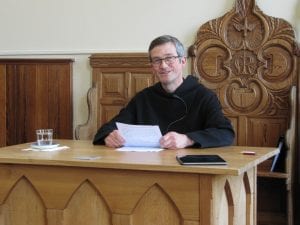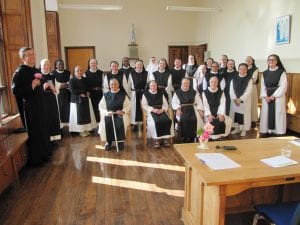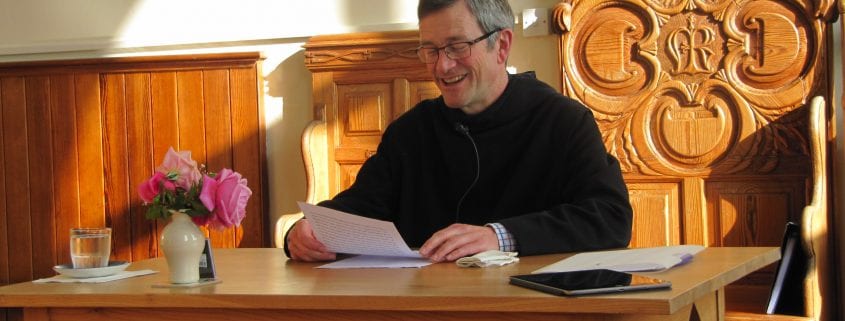Conference 14 – 18 Sept 2020: The Rule of St Benedict & The Little Prince
Fr Luke McNamara OSB is a monk of Glenstal Abbey and a lecturer in sacred scripture at St Patrick’s College, Maynooth. As a follower of the Rule of St Benedict he is well equipped to lead us in a reflection on this ancient monastic rule as a source and guide for our monastic life today. In this series of conferences, he did so with the help of the much loved story of The Little Prince, pointing out that both works are interested in encouraging us to be open to mystery and true wisdom.
In his opening conference, Fr Luke highlighted that both authors point out the need for a quality of deep hearing and seeing to engage with life’s deeper realities. St Benedict opens his rule with ‘Listen, O child, to the precepts of the master and incline the ear of your heart’. Antoine de St Exupery, in The Little Prince, also teaches that perception takes place in the heart “One sees clearly only with the heart; what is important is invisible to the eyes.”

What can monastics and spiritual seekers take from The Little Prince and The Rule of St Benedict for their journey? We share an excerpt from Fr Luke’s talks here:
‘The Rule of St Benedict provides compass points to navigate human reality. In like manner The Little Prince guides readers through the key questions of life: Who we are? Where we are? Why we are? How we are? Within the story world readers are invited to suspend the limited rational view of science, dwell in their house of being and attune to wisdom. For the rule, wisdom is located in Christ and his words. Although Saint Exupéry was a non-believer, he acknowledged wisdom wherever he found it.
It is the Little Prince that awakens the character of the pilot in St Exupery’s story to the mystery of life. While time may pass, monastics are characterised by an original awakening, a questioning, a seeking. It is good to revisit these moments which are different and personal for each of us, but these moments are part of who we are as monastics. The prologue begins with a call (“Hear and heed my child”) and continues with a dialogue. Monastics listen not simply with the ear but with their whole being. The word is spoken in the context of a relationship, that of a child and loving Father. The paternal-child and family metaphor emphasises the constancy of the love, the indelible nature of the relationship. The advice is to be received willingly, cheerfully, with vigour – libenter. This adverb sets the context for the whole prologue and much of the rule. The term ‘rule’ which conjures up notions of restrictions or limits, in fact is designed to do the opposite. The purpose is to free those who live under the rule to live life fully, eagerly and generously under the loving gaze of the Father.
The prologue is densely woven with quotations from scripture and in particular from two psalms, namely psalms 15 and 34. These psalms provide the questions of the prologue, questions that are addressed to potential monastics. The questions outline the pitch of Benedict, a latter-day recruiting sergeant in the market place, to his potential recruits.
“Who is the one who loves life and wants to see good days?” (Prol 15; Psa 34:13)
Life and happiness certainly present a good sales pitch. Benedict is proposing a way that meets a universal desire. This is important. While only a few may be called to become monastics, the way of the monastic is a beacon to all humanity, because the monastic is to be a model of living life well. It is not Benedict or his recruiting sergeant who speaks in the market place, but it is the voice of the Lord himself who invites the monastic (Prol 19). There is no sweeter sound for those with ears to hear.
The psalm gives a response to its question which Benedict quotes: “Then keep your tongue from evil and your lips from speaking deceit, turn from evil and do good, seek peace and pursue it.” (Prol 17; Psa 34:13). The sister who responds positively to this call enters into a dialogue with the Lord who in turn rests his eyes upon her, opens his ears to her prayers and answers her prayers even before she calls with a “Here I am”. This is the standard response of a biblical figure to a call from God, but here it is the Lord who responds in a two-way relationship with us – “Here I am”. This is not a “I’ll see you sometime” “We must catch up”, but “Here I am”. Christ arrives or is present to us even as we begin to set out towards him. Benedict proposes a great calling, a true relationship in which we are invited to participate. Note the central aspect of our response – it is to seek peace and pursue it – inquire pacem et sequere eam. The goal is to attain peace and then we will live in this wonderful relationship – thus pax is a fitting motto for our order.
The second set of questions comes from Psalm 15. “Lord who shall be a guest in your tent and who shall dwell on your holy mountain?” This question shifts emphasis and concentrates on the destination of the one who accepts the call to follow, it is nothing less that the Lord’s own dwelling place. The promised relationship is not long-distant, but intimate (father – child) and close (same dwelling place). The question sets before the potential monastic disciple a wonderful horizon of expectation. Again the prologue quotes the corresponding response of psalm 15: “The one of blameless heart who does what is right, who speaks the truth from his heart and does not slander with his tongue, who never wrongs a friend and tells no tales against his neighbour….and continues with….. who shatters the devil’s thoughts on Christ, who fears the Lord..” The focus here is ultimately on Christ and the recognition of Christ’s work within – “not unto us O Lord, not unto us, but to your name be the glory”. For the work that the monastic manages to do, exceeds his own capacity, for it is the Lord’s work. The monk who answers the call and seeks peace, becomes aware of the Lord working within him to transform him and the world about him. The work of Christ is central to the physiology of a healthy monastic.’
Thank you Fr Luke for some very stimulating talks to help us on our way.




